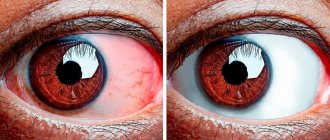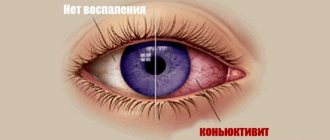Now, according to statistics, there are about 130 million people on the planet who have poor vision, and about 35-37 million who are unable to see at all. The reasons for this can be both congenital and acquired characteristics of human health. Most often, the process of vision deterioration occurs quite slowly, gradually, and a person has time to either adapt to it or take measures that can stop the process. But sometimes there is a sharp deterioration in vision. The reasons that caused this process may be different.
Sudden deterioration of vision: causes
First signs
- 5.1 Video: What to do if distance vision deteriorates
- 6.1 Video: Causes of decreased vision
If the quality of vision has deteriorated sharply, then the person becomes not only unable to lead his usual lifestyle, but often falls into a depressive state, which can turn into panic. The thing is that each of us receives the lion's share (up to 90%) of information about the environment through our eyes. Reading, watching interesting videos and TV, surfing the Internet and even finding the right place on the street - all this simply requires well-seeing eyes.
Causes of visual impairment
What happens at the moment when a person’s vision deteriorates? The very first symptom is the inability to clearly see surrounding objects, especially those located far away. Also, images become blurry, a “veil” may hang before the eyes, and blurred vision is felt. Problems begin with obtaining information visually, the inability to read, etc. The more vision deteriorates, the more difficult it becomes to navigate in space.
Symptoms of visual impairment
Attention! Sometimes vision deterioration, especially severe, may not occur due to the development of any eye diseases. Often the cause of this condition is some pathology of organs not related to the eyes.
Table. Types of vision impairment.
| Type | brief information |
| Bilateral | In this case, vision deteriorates in both eyes. Usually the reason lies in neurogenic processes. |
| Unilateral | Here, visual impairment is observed in only one of the eyes. Often associated with some local cause. These may be defects in eye tissue, vascular pathologies, etc. |
Lost vision in one eye
Treatment of vision impairment
Most often, in case of vision problems, they resort to conservative correction or surgical treatment.
Conservative treatment
The conservative part of the program includes correction with glasses. Lenses, hardware techniques, gymnastics and eye massage (see eye gymnastics). For degenerative pathologies, vitamins are added.
- Spectacle correction allows you to reduce the risks of strabismus, retinal detachment due to myopia, farsightedness, and also correct complex types of visual impairment (astigmatism in combination with myopia or hyperopia). Glasses somewhat limit the field of vision and create difficulties when playing sports, but they do the job quite well, allowing you to supply your eyes with any type of necessary lenses.
- Aesthetes and those who make money thanks to their appearance resort to lenses. The main complaints about this type of correction are complex hygienic requirements. Risks of bacterial and protozoal complications, lack of full air penetration into the eye. In general, modern lenses offer both disposable and breathable options.
- Gymnastics and massage help improve blood supply to all structures of the eye, make the oculomotor and ciliary muscles work, and are suitable for correcting simple weak degrees of myopia or farsightedness.
- Hardware techniques – classes with an instructor with or without glasses on special installations that train the eye muscles.
Operational aids
- Cataracts today are successfully treated only by removing the clouded lens with or without its replacement.
- Tumor and some vascular processes can also be corrected exclusively by surgery.
- Laser welding of the retina allows you to solve the problem of tears or partial detachment.
- The PRK method is the earliest variation of corneal laser correction. The method is quite traumatic, requires long-term rehabilitation and is contraindicated for both eyes at the same time.
- Lasers are also used today to correct visual acuity (farsightedness of 4 diopters and myopia of 15, astigmatism within 3). The LASIK method (laser assisted keratomileusis) combines mechanical keratoplasty and laser beams. A corneal flap is peeled off with a keratome, the profile of which is adjusted with a laser. As a result, the cornea decreases in thickness. The flap is welded into place using a laser. Super-LASIK is a variation of the operation with very gentle grinding of the corneal flap, which is based on data on its curvature and thickness. Epi-LASIK allows you to avoid staining the corneal epithelial cells with alcohol and correct marginal distortions (aberrations) of vision. FEMTO-LASIK involves the formation of a corneal flap and its treatment with a laser.
- Laser correction is painless, leaves no stitches, and requires little time, including recovery. But some of the long-term results leave much to be desired (dry eye syndrome, inflammatory changes in the cornea may occur, the corneal epithelium may become excessively rough, and sometimes corneal ingrowths may develop).
- Surgical laser intervention is not performed on pregnant women, nursing mothers, or children under 18. This technique cannot be used on a single eye, with glaucoma, insufficient corneal thickness, autoimmune pathologies, with cataracts, immunodeficiency, progressive forms of myopia, operated retinal detachment, or with herpes.
Thus, the problems of vision loss are very diverse. They often progress, leading to complete loss of vision. Therefore, it is the early detection of pathologies of the visual analyzer, their prevention and correction that can protect a person from disability.
Bilateral vision loss
This process may occur in the following cases:
- ischemic optic neuropathy , when the retina of the eyes is affected. Often occurs due to aortic arch syndrome with a sudden change in body position;
- a bilateral heart attack is often accompanied by a failure of color vision , this symptom is usually noted in older people;
- Retrobulbar neuritis is one of the symptoms of common multiple sclerosis, occurring in approximately 16% of cases. Usually in this case problems arise with central vision;
- increased intracranial pressure is often accompanied by amblyopia, the duration of which can vary from seconds to minutes;
- In the case of temporal arteritis, the vessels of the head and eyes are affected, which is why vision deteriorates.
If your vision has suddenly deteriorated, what should you do? You should immediately consult a doctor without postponing the visit until later
Cause
The reasons for the development of the condition are varied. These may be disorders of the cardiovascular system, metabolic diseases, damage to eye tissue, and central nervous system disorders. It is important for the doctor to identify the root cause, since further treatment will depend on it.
Vascular thrombosis
Increased platelet aggregation and an increase in the amount of blood clotting factors lead to the development of thrombosis. It can clog the vessels of the spine, brain, and microcirculation of the eyes. The organ that is hit atrophies and dies. If the clot has passed further and the blockage has been removed, vision is restored.
Impaired functionality of the visual organs
The following reasons fall into this category:
- an attack of glaucoma, that is, an excessive increase in intraocular pressure that damages the retina and optic nerve;
- retinal detachment;
- disruption of retinal microcirculation, which leads to its gradual atrophy;
- inflammatory processes in the optic nerve.
Diagnosis and treatment are carried out by an ophthalmologist. To find the root cause, it is necessary to examine the fundus of the eye and identify the lesion.
Complications of diabetes
During the disease, conglomerates of glucose and cholesterol are formed, which circulate through the blood. They can clog the microcirculation vessels of the eyes. In this case, the patient will lose vision for a while. If the conglomerates move further, it will be restored; if they remain in place, the patient may completely lose the function of the eyeballs.
Central nervous system disorder
The following conditions and diseases fall into this category:
- the growth of a malignant or benign tumor that damages the visual center;
- degenerative processes in the visual center or nerves that go to the eyeballs;
- increased intracranial pressure, damaging blood vessels and causing hemorrhages.
In this case, treatment will be carried out by a neurologist. To identify the lesion, MRI and CT are performed.
Cardiovascular disorders
This category of disorders includes the following conditions and diseases:
- blockage of blood vessels in the brain, which causes a stroke;
- hypertensive crisis;
- brain hypoxia (decreased oxygen supply).
When contacting a cardiologist, a comprehensive analysis of the cardiovascular system is performed. The root cause of the development of temporary vision loss is identified. Complex treatment is carried out using medications.
Vision correction using contact lenses
Lenses vary in length of wear. For example, one-day lenses from Bausch+Lomb Biotrue® ONEday are popular. They are made of HyperGel material, which is similar to the structures of the eye and tears, contains a large amount of moisture - 78% and provides comfort even after 16 hours of continuous wear. This is the best option for dryness or discomfort from wearing other lenses. There is no need to care for these lenses; a new pair is worn every day.
There are also scheduled replacement lenses - silicone hydrogel Bausch + Lomb ULTRA, using MoistureSeal® technology (MoistureSeal). They combine high moisture content, good oxygen permeability and softness. Thanks to this, the lenses are not felt when worn and do not damage the eyes. Such lenses require care using special solutions - for example, ReNu MultiPlus (Renu MultiPlus), which moisturizes and cleans soft lenses, destroying viruses, bacteria and fungi, is used to store lenses. For sensitive eyes, the ReNu MPS solution with a reduced concentration of active ingredients is optimal. Despite the softness of the formula, the solution effectively removes deep and superficial stains. For long-term hydration of lenses, solutions with hyaluronic acid, a natural moisturizing component, have been developed. For example, the universal solution Biotrue (Biotru), which, in addition to removing dirt, bacteria and fungi, provides 20-hour hydration of lenses due to the presence of hyaluronan polymer in the product.
Special gymnastics and a number of relaxing exercises help improve the condition of the eyes. They will be especially useful for those who work a lot at the computer. The simplest exercise is to close your eyes and contemplate imaginary nature. Sometimes people just visualize pleasant moments in life or dream.
Gymnastics for the eyes
Attention! Eyes can get tired not only because of work, but also because of emotional stress. Therefore, going back to the past and remembering pleasant moments would be a good idea to replenish internal resources and relax.
It is important to take care of your diet. It must be balanced and supply the body with all the nutrients it needs to function.
Nourishment for eyes
It is also important to have regular eye exams with an ophthalmologist. At the first signs of vision deterioration, you should consult a doctor immediately to identify the causes and prescribe the correct treatment. It may also be necessary to visit other specialists if the deterioration of vision is not associated with ophthalmological processes.
Video: What to do if distance vision deteriorates
How to strengthen your eyesight?
Step 1. Carrots are rich in vitamin A, which is necessary for proper eye function. Therefore, it is important to eat as many carrots as possible in different forms. It is also important to eat foods rich in iron and zinc.
Eat more carrots
Step 2. Surprisingly, action games can help strengthen your eyes. This is reported by the results of a study conducted by scientists published in 2007. The eyes seem to train when they follow the active actions taking place on the screen. So you need to change your favorite genre of games to “action”.
Play action games
Step 3. You need to include several walks in the fresh air in your daily routine, and during your vacation, be sure to get out into nature.
Walk in the fresh air
Step 4: It is recommended to take supplements containing lutein, zeaxanthin, and blueberries. They have a beneficial effect on the eyes.
Special Additives
Step 5. You should visit an ophthalmologist regularly to check the condition of your eyes. This will help prevent the development of any diseases and take timely measures to improve vision if necessary.
Visit your ophthalmologist regularly
Step 6. It is important to limit the time spent at the computer or watching TV. Stress on the eyes must be strictly dosed. If this cannot be done, then you need to periodically break and do eye exercises.
Limit the time spent on the computer or watching TV
Step 7: Sports and exercise will help strengthen your eyes. It is recommended to include at least 1-2 workouts per week into your schedule.
Physical exercise
Step 8. If necessary, laser vision correction is performed.
Laser vision correction











